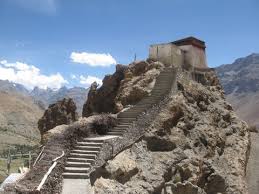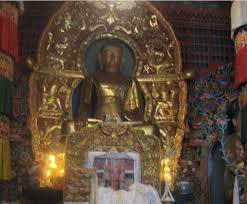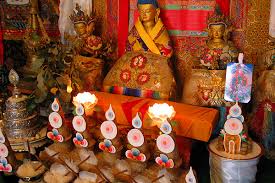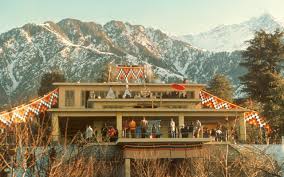
 Lahaul and Spiti is the remote Himalayan valleys of Himachal Pradesh, lying on the Indo-Tibet border. A high altitude cold desert, the region is dotted with famous monasteries, villages like little green oases in a stark, brown and dry landscape, miles of rolling pastures, 6000m peaks and swollen rivers which turn into mere trickles in winter. It is a fascinating land for Buddhist art and culture. Among these glaciers, high ridges, broad valleys, pastures is situated world famous Dhankar Monastery.
Lahaul and Spiti is the remote Himalayan valleys of Himachal Pradesh, lying on the Indo-Tibet border. A high altitude cold desert, the region is dotted with famous monasteries, villages like little green oases in a stark, brown and dry landscape, miles of rolling pastures, 6000m peaks and swollen rivers which turn into mere trickles in winter. It is a fascinating land for Buddhist art and culture. Among these glaciers, high ridges, broad valleys, pastures is situated world famous Dhankar Monastery.
Dhankar Monastery
Dhankar situated on the altitude of 12,774 feet above the sea level, south of Kaza around 24 kms. It was traditional Capital of Spiti valley date back to 17the century. The Dhankar Castle is sets picturesquely on a clay hill above Shichilling village. Now new monastery has already constructed below the Castle. There is a natural Lake at about 13,500 feet. Behind the village around 2kms. The Dhankar monastery belongs to Gelugspa School of order.
The Gompa has over 150 monks, some fascinating 'thangka' sculptures and a statue of the 'Dhyan Buddha'. Some of the Gompas were destroyed during a particularly harsh winter in 1989. Principal figure is a Statue of " Vairochana" (Dhayan Budha) consisting of 4 complete figures seated back to back. It has relics in the shape of paintings and sculptures.

 Lahaul and Spiti is the remote Himalayan valleys of Himachal Pradesh, lying on the Indo-Tibet border. A high altitude cold desert, the region is dotted with famous monasteries, villages like little green oases in a stark, brown and dry landscape, miles of rolling pastures, 6000m peaks and swollen rivers which turn into mere trickles in winter. It is a fascinating land for Buddhist art and culture. Among these glaciers, high ridges, broad valleys, pastures is situated world famous Dhankar Monastery.
Lahaul and Spiti is the remote Himalayan valleys of Himachal Pradesh, lying on the Indo-Tibet border. A high altitude cold desert, the region is dotted with famous monasteries, villages like little green oases in a stark, brown and dry landscape, miles of rolling pastures, 6000m peaks and swollen rivers which turn into mere trickles in winter. It is a fascinating land for Buddhist art and culture. Among these glaciers, high ridges, broad valleys, pastures is situated world famous Dhankar Monastery.
Dhankar Monastery
Dhankar situated on the altitude of 12,774 feet above the sea level, south of Kaza around 24 kms. It was traditional Capital of Spiti valley date back to 17the century. The Dhankar Castle is sets picturesquely on a clay hill above Shichilling village. Now new monastery has already constructed below the Castle. There is a natural Lake at about 13,500 feet. Behind the village around 2kms. The Dhankar monastery belongs to Gelugspa School of order.
The Gompa has over 150 monks, some fascinating 'thangka' sculptures and a statue of the 'Dhyan Buddha'. Some of the Gompas were destroyed during a particularly harsh winter in 1989. Principal figure is a Statue of " Vairochana" (Dhayan Budha) consisting of 4 complete figures seated back to back. It has relics in the shape of paintings and sculptures.

 In the insurmountable heights of Spiti, lies the Buddhist gompa, monastery of Tabo. It was the Tibetan year of the Fire Ape and the founder was the great teacher Rinchensang Po, also known as Mahaguru Ratnabhadra. With its exquisite murals and stucco images, Tabo is often called 'The Ajanta of the Himalayas'. Tabo is located at a height of 3050 metres in the magnificently isolated Spiti valley in Himachal Pradesh.
In the insurmountable heights of Spiti, lies the Buddhist gompa, monastery of Tabo. It was the Tibetan year of the Fire Ape and the founder was the great teacher Rinchensang Po, also known as Mahaguru Ratnabhadra. With its exquisite murals and stucco images, Tabo is often called 'The Ajanta of the Himalayas'. Tabo is located at a height of 3050 metres in the magnificently isolated Spiti valley in Himachal Pradesh.
With breathtaking murals and stucco images, Tabo is often called 'The Ajanta of the Himalayas'. And here is the art that above all, is born of religion and deep faith. A small community of sixty monks resides here. The monastery has clay statues of the Buddha painted in the Kashmiri style.
The main temple, Tsug Lhakang was at the centre of the whole complex. The centre of this temple was also the center of the compound along the east-west axis, having its major statue, Saravid Vairochana, placed in the central spot not only of its surrounding 32 statues in a perfect three-dimensional mandala around him - and therefore of the temple - but also of the whole complex.

 The Rumtek Monastery or the Dharma Chakra Center is one of the most important seats of the Kagyu lineage outside Tibet. In the early nineteen sixties, His Holiness the Sixteenth Gyalwang Karmapa founded this seat near the three hundred year old Kagyu monastery built in the sixteenth century by the Fourth King of Sikkim under the guidance of the ninth Karmapa. The new Rumtek monastery was built about two kilometers away from this old monastery.
The Rumtek Monastery or the Dharma Chakra Center is one of the most important seats of the Kagyu lineage outside Tibet. In the early nineteen sixties, His Holiness the Sixteenth Gyalwang Karmapa founded this seat near the three hundred year old Kagyu monastery built in the sixteenth century by the Fourth King of Sikkim under the guidance of the ninth Karmapa. The new Rumtek monastery was built about two kilometers away from this old monastery.
Dharma Chakra Center includes a beautifully structured main shrine temple and monastery with monks' quarters, where the Karmapa resides and where the most of the important relics are enshrined; a three-year retreat center; a Shedra, or monastic college, where the relics of the Sixteenth Karmapa are enshrined; a nunnery; stupas; a protector's shrine; institutions for the lay community; and other establishments.
The monastery holds annual events for the public. Two of the most festive and important events are held each summer and winter. In the fourth lunar month of the Tsurphu Tibetan calendar either the Guru Rinpoche or the Vajrakilaya Drupchen (great sadhana practice retreat) take place.
The Rumtek Monastery is located in eastern Sikkim, 24 kilometers away from Gangtok, the capital of the Sikkim, India. The best season to visit, in terms of weather, is March to late May, or from October to mid-December. The following languages are spoken in the area: Sikkimese, Pahari (the local Nepalese dialect), Hindi, Tibetan and English.
 In 1575 Sonam Gyatso, the Third Dalai Lama, officially founded a monastery, which later came to be known as Namgyal Dratsang (Victorious Monastery). Since its inception, the monastery has assisted the Dalai Lamas in their public religious activities and performed ritual prayer ceremonies for the welfare of Tibet.
In 1575 Sonam Gyatso, the Third Dalai Lama, officially founded a monastery, which later came to be known as Namgyal Dratsang (Victorious Monastery). Since its inception, the monastery has assisted the Dalai Lamas in their public religious activities and performed ritual prayer ceremonies for the welfare of Tibet.

The monastery has been a center of learning, contemplation and meditation on the vast and profound Buddhist treatises. Namgyal monastery is nonsectarian and maintains ritual practices and teachings of the four main lineages of Tibetan Buddhism.
In Tibet, the 175 Namgyal monks and their monastery were located in the Potala Palace, performing spiritual duties and religious ceremonies for both the Dalai Lama and the Tibetan Government. A distinctive feature of this monastery is its diversity of practice: prayers and rituals of all the major schools of Tibetan Buddhism are performed by Namgyal monks. The monastery is now situated next to the Central Cathedral.